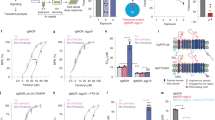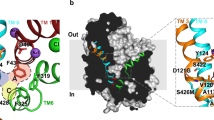Abstract
Cultured mouse neuroblastoma cells (N4TG1)1,2 and neuroblastoma–glioma hybrid cells (NG108-15)3–5 contain enkephalin (δ) receptors2. Studies on hybrid cells have indicated that occupation of enkephalin receptors by opiates and opioid peptides leads to a time-dependent inhibition of adeny-late cyclase activity3–5. If exposure of these cells to agonists is continued, the activity of adenylate cyclase gradually returns to normal and increases above normal on removal of opioids, a phenomenon thought to resemble tolerance and dependence in animals. Direct receptor binding studies on neuroblastoma cells have shown no internalization of receptors1. Using rhodamine-conjugated [D-Ala2,Lys6]Leu-enkephalin and image-intensified fluorescence microscopy, enkephalin (δ) receptors in neuroblastoma cells were found slowly to form clusters which do not appear to be internalized6. This is in contrast to many polypeptide receptors7–12 which are internalized after the initial receptor–ligand interactions. This internalization is believed to be related to the so-called down-regulation or desensitization. We now report that after one to several hours exposure of monolayer cell cultures to enkephalin, the number of enkephalin receptors measured subsequently in the extensively washed membrane preparations is greatly reduced. This reduction in receptor number seems to be selective for opioid peptides and is antagonized by a variety of opiate agonists and antagonists. These observations may be important in elucidating the phenomenon of opioid-induced desensitization.
This is a preview of subscription content, access via your institution
Access options
Subscribe to this journal
Receive 51 print issues and online access
$199.00 per year
only $3.90 per issue
Buy this article
- Purchase on Springer Link
- Instant access to full article PDF
Prices may be subject to local taxes which are calculated during checkout
Similar content being viewed by others
References
Chang, K.-J., Miller, R. J. & Cuatrecasas, P. Molec. Pharmac. 14, 961–970 (1978).
Chang, K.-J. & Cuatrecasas, P. J. biol. Chem. 254, 2610–2618 (1979).
Sharma, S. K., Klee, W. A. & Nirenberg, M. Proc. natn. Acad. Sci. U.S.A. 72, 3092–3096 (1975).
Lampert, A., Nirenberg, M. & Klee, W. A. Proc. natn. Acad. Sci. U.S.A. 73, 3165–3167 (1976).
Klee, W. A. & Nirenberg, M. Nature 263, 609–612 (1976).
Hazum, E., Chang, K.-J. & Cuatrecasas, P. Science 206, 1077–1079 (1979); Nature 282, 626–628 (1979); Proc. natn. Acad. Sci. U.S.A. 77, 3038–3041 (1980).
Hazum, E., Chang, K.-J. & Cuatrecasas, P. Neuropeptides 1, 217–230 (1981).
Schlessinger, J., Shechter, Y., Willingham, M. C. & Pastan, I. Proc. natn. Acad. Sci. U.S.A. 75, 2659–2663 (1978).
Levi, A., Shechter, Y., Neufeld, E. & Schlessinger, J. Proc. natn. Acad. Sci. U.S.A. 77, 3469–3473 (1980).
Maxfield, F. R., Schlessinger, J., Shechter, Y. & Pastan, I. Cell 14, 805–810 (1978).
Niedel, J. E., Kahane, I. & Cautrecasas, P. Science 205, 1412–1414 (1979).
Hazum, E., Cuatrecasas, P., Marian, J. & Conn, P. M. Proc. natn. Acad. Sci. USA 77, 6692–6695 (1980).
Chang, K.-J., Hazum, E. & Cuatrecasas, P. Proc. natn. Acad. Sci. U.S.A. 77, 4469–4473 (1980).
Chang, K.-J., Cooper, B. R., Hazum, E. & Cuatrecasas, P. Molec. Pharmac. 16, 91–104 (1979).
Bowen, W. D., Gentleman, S., Herkenham, M. & Pert, C. B. Proc. natn. Acad. Sci. U.S.A. 78, 4818–4822
Wei, E. & Loh, H. 3, 1262–1263 (1976).
Pert, C. B. & Snyder, S. H. Science 182, 1359–1361 (1973).
Klee, W. A. & Nature 248, 61–63 (1974).
Höllt, V., Dum, J. Biasrg, J., Schubert, P. & Herz, A. Life Sci. 16, 1823–1828 (1975).
Simon, E. J. & Hiller, J. M. Fedn Proc. 37, 141–146 (1978).
Chang, K.-J., Hazum, E. & Cuatrecasas, P. Proc. natn. Acad. Sci. U.S.A. 78, 4141–4145 (1981).
Schulz, R., Wüster, M., Krenss, H. & Herz, A. Nature 285, 242–243 (1980).
Author information
Authors and Affiliations
Rights and permissions
About this article
Cite this article
Chang, KJ., Eckel, R. & Blanchard, S. Opioid peptides induce reduction of enkephalin receptors in cultured neuroblastoma cells. Nature 296, 446–448 (1982). https://doi.org/10.1038/296446a0
Received:
Accepted:
Issue Date:
DOI: https://doi.org/10.1038/296446a0
This article is cited by
-
Down-regulation of 3H-lofentanil binding to opiate receptors in different cultured neuronal cells
Naunyn-Schmiedeberg's Archives of Pharmacology (2004)
-
Cellular mechanism for anti-analgesic action of agonists of the κ-opioid receptor
Nature (1997)
-
Genetic mapping of opioid binding protein gene(s) to mouse Chromosome 9
Mammalian Genome (1993)
-
Enhanced development of morphine tolerance in rats treated with 2-deoxy-d-galactose
Psychopharmacology (1991)
Comments
By submitting a comment you agree to abide by our Terms and Community Guidelines. If you find something abusive or that does not comply with our terms or guidelines please flag it as inappropriate.



